Kostenloser Versand ab 30€ Bestellwert!
-
Shop
- Insights
-
Über ROMBO
- Händler
- Plektren-Finder
- Geschenkgutschein
+Kategorien
- accessories
- bass
- bass pick
- bass picks
- bass plectrum
- bass plectrums
- beginner
- bright tone
- chose guitar pick
- chose guitar picks
- chose plectrum
- chose plectrums
- CrystalBright
- Diamond
- Diamond pick
- discipline and guitar
- DIY generation
- durability pick
- durable pick
- eco
- ecoblack
- find guitar pick
- find plectrum
- fingers vs picks
- grip
- grip guitar pick
- guitar accessories
- guitar advantages
- guitar benefits
- guitar career
- guitar health
- guitar injury
- guitar learn
- guitar lesions
- guitar lesson
- guitar method
- guitar noise
- Guitar noise plectrum
- guitar pain
- guitar pick
- guitar pick beginner
- guitar pick bevel
- guitar pick buy
- Guitar pick diamond
- guitar pick durability
- guitar pick durable
- guitar pick eco
- guitar pick features
- guitar pick grip
- guitar pick material
- Guitar Pick Noise
- Guitar Pick online
- guitar pick recycled
- guitar pick recycled material
- guitar pick special features
- guitar pick textures
- guitar pick thickness
- guitar pick variable thickness
- guitar picks
- guitar tone
- guitar warm-up
- guitarpick
- guitarpicks
- hold a guitar pick
- hold guitar pick
- hold guitar picks
- hold pick
- hold plectrum
- hold plectrums
- how to
- how to chose your guitar picks
- jazziii
- learn guitar
- lose guitar pick
- material
- materials
- mental health and guitar
- motivation and guitar
- music
- not to lose guitar pick
- Online guitar
- online guitar pick
- online guitar pick buy
- pick
- pick durability
- pick material
- pick noise
- Picks
- picks vs. fingers
- play bass fingers
- play bass picks
- play bass with fingers
- play bass with pick
- play bass with picks
- play bass with plectrum
- play guitar faster
- plectrum
- plectrum attributes
- plectrum beginner
- plectrum bevel
- plectrum characteristics
- plectrum features
- plectrum grip
- plectrum material
- plectrum noise
- plectrum recycled
- plectrum shape
- plectrum variable thickness
- plectrums
- Plek
- pua
- recycled
- recycled guita pick material
- recycled guitar picks
- recycled picks
- recycled plectrum
- Rombo Diamond
- rombopicks
- tendonitis guitar
- the guitar pick
- tone
- variable thickness
- warm tone
- warm-up guitar

Why a guitar pick variety pack is a great choice for beginner and advanced guitar players
1- What is a Guitar Pick Variety Pack
A Guitar Pick Variety Pack is a set of at least three different guitar picks aimed to contain different shapes, sizes, materials, or thicknesses of plectrums.
There are other common names for this type of guitar pick set, like “Try out Mix,” “Guitar Pick Mix Set,” or “Guitar Pick Box.” Some variety packs are focused on specific guitar areas like a “Heavy Gauge Variety Pack,” thought to be used by advanced players or “Beginner’s Variety Pack” containing medium and thin guitar picks.

On guitar picks, qualities like thickness, shape, size, and material play a pivotal role in the guitar tone, sustain, grip, or pick noise.
Therefore, it is not only about the personal preferences of the player but also about the techniques you want to develop. Your hands do an arduous job, give them the proper tools they need.
2- Reasons why a Variety Pack is a good idea
REASON ONE - It is the fastest and cheapest way of changing your guitar tone
Think about it: The guitar, strings, amp, cable, and effects pedals are all pieces of the guitar gear that play a role in tone. Surprise: guitar picks too!
Use a rounded thick nylon pick and you’ll get mellower, darker, and thicker tones. Use a pointy medium Tortex guitar pick and your tone will be as bright as you can imagine.
It only takes two seconds and the cost of a coffee to change your pick and increase your tone spectrum. Larger tone repertoire means larger versatility.
Music is about staying dynamic, and monotony kills dynamics. Therefore, your most logical step as a guitarist is to find ways of expanding your repertoire of tones and techniques. This happens with practice and the right guitar gear.

REASON TWO - The joy of exploration
Music theory, speed exercises, precision exercises, and warm-ups all have one thing in common: They focus on improvement, repetition, and perfection.
However, performance is not everything and sometimes we should focus on the joy of exploration.
The greatest ideas happen when we achieve a “flow” state, also known as the “zone.” This applies to guitar too! So, why not relax for a day, test some new pieces of gear, spark some creativity by playing around some guitar phrases, and then see what happens without planning too much and having the pressure of achieving one specific performance milestone?
Chose 4-5 different picks, turn on the amp, and give yourself a two hours break by enjoying the music you are playing now.
PS: Don’t forget to turn off your phone!
REASON THREE - Develop specific skills
Try to perform your speed exercise with a large, worn-out, thin guitar pick. Let’s say 0.35 mm.
You will face one of these three scenarios:
- You are slower than usual.
- You are as fast as usual but your technique is bad.
- You are slower and your technique is bad.
As in every discipline, using the right tools is the key to success.
“Modern Guitars” are attributed to Spanish musician, Antonio de Torres Jurado. He was a luthier, and in the mid-1800s, he began creating the style of guitar that would rise to all modern guitars.

Imagine then how immense the number of available guitar techniques that had more than a dozen decades to be developed is. From strumming to hybrid picking, palm mute, sweep picking, or down picking, all these techniques have different requirements, and different requirements can be fulfilled with different tools.
In our article, “7 essential guitar pick techniques,” we have summarized some of the most common techniques.
REASON FOUR - Different instruments
Sure, the average guitar player owns a red Stratocaster with 09 strings and plays classic rock.
But what about the rest of us? The 7 strings shredders, the acoustic unplugged fans, the indie effect experts, the experimental music lovers, the metal-heads, the bassists using picks, and the jazz/bossa relaxed musicians out there?
We all deserve to have a choice according to our requirements.

Personally, I like to play bass with a medium pick (Rombo Prisma), and I love the warm tones of Rombo Horizon for guitar reverb phrases on my telecaster. However, when I feel like using the thickest metal distortion ever, I choose Rombo Diamond.
Different guitar pick shapes, sizes, materials, and thicknesses create a widely broad tonality and usability ranges that I need to keep my motivation up!
REASON FIVE - A fresh input kills routine!
Did you use the same guitar pick for the last 20 years? Well, it’s never too late to get a little bit of fresh air and try something new.
Even the riff you have played 1000 times will sound different and you might notice that there are some nuances on “pick feedback” that can make your sound more fun and interesting.
What is the worst that can happen? In the worst case, you will discover a guitar pick that you prefer more than your usual! Go take that risk :-)
REASON SIX - A Guitar Pick Variety Pack is a great gift
Guitar players have a lot of things going on in their heads: the next gig, one unfinished song composition they started some weeks ago, the speed rates of their last practice, and more.

A Guitar Pick Variety Pack is a great gift for beginners, intermediate, or advanced players. Guitarists love trying new gear because it is a way to spark some creativity and explore tonalities.
A variety pack is a super affordable option for a small, but elegant gift to make a guitarist smile and feel excited for the next practice day.
There are many different gift options from Rombo:

If only one of the guitar picks is chosen as the new favorite one, your friend will be thankful for life!
REASON SEVEN - Reflecting on your guitar tone and level
Even if you don’t like the picks included in the variety pack, they will have a positive effect on your playing.
You will reflect and confirm why you had chosen your current pick in the past and what the advantages of it are. You will reflect on your guitar tone and the nuances of guitar pick feedback and pick noise.
These experiences accumulate, and after years of exploration, you start having a sixth sense of “feeling” your instrument, your preferences, and music in general.
What do you do with your new picks? Well, if you don’t like them, give them to a friend that could need inspiration!
3- Who can profit from Guitar Pick Variety Packs (Spoiler: Everyone)
From the reasons above, we can take away a clear lesson: It doesn’t matter if you are a beginner or an advanced player, the advantages of trying a Guitar Pick Variety Pack are always there.
Why beginners profit from Guitar Pick Variety Packs:
- Develop new skills.
- Develop a sense of exploration and identify tone nuances.
- Understand that different techniques need different requirements.
- Understand that the guitar path is a long one and that not everything is performance.
Why intermediate and advanced players profit from guitar pick variety packs:
- Expand the spectrum of techniques.
- Discover an unexpected tonality change.
- Focus on one specific technique.
- Joy of exploration.
4- Examples of a guitar pick variety pack
One example is our own guitar pick variety pack containing:
- 1 Rombo Classic | 0.45 mm
- 1 Rombo Origami | 0.75 mm
- 1 Rombo Prisma | 0.8 mm
- 1 Rombo Crisp | 1 mm
- 1 Rombo Waves | 1.25 mm
- 1 Rombo Horizon | 1.4 mm
- 1 Rombo Diamond | 2 mm
- 1 Rombo Jade | 2.3 mm
It is not only thickness that is everything. In order to make these picks more understandable for you, we have created four metrics: Attack, Flexibility, Tone, and Techniques. Here an example:

With this information, and in combination with the description of the pick and the technical drawing, we give you a very precise picture of the qualities of our guitar picks.
We also have a specific set for beginners with the “Beginners Guitar Pick Gift Box”:
And a specific set for intermediate/advanced players.

5- Conclusion
A Variety Pack is not only an excellent gift for your musician friends, but also for yourself if you are looking to explore tones, develop specific skills, or just need fresh air and try new guitar gear.
Different qualities like shape, thickness, or material, make guitar picks very different tools for different requirements. You will learn a lot in the process of testing them and every fresh input can help keep your motivation at the highest level.
The worst case: You will discover your new favorite pick!


Wie du das richtige Plektrum auswählst
Wir alle wissen, wie komplex Plketren sein können. Eigenschaften wie Plektrumdicke, Material, Form und Größe definieren den Charakter eines Plektrums.
Wir möchten dir helfen, eine der schwierigsten Aufgaben zu lösen, mit der jeder Gitarrist konfrontiert ist: wie man das richtige Plektrum auswählt.

1. Was sind Gitarrenpicks?
Das Plektrum ist die Brücke zwischen dir und deinem Instrument, ein versteckter Held in den Händen der meisten Gitarristen und der lauteste Verstärker in deinen Händen. Wenn du eine bessere Definition hast, würden wir uns freuen, sie zu hören!
Ein Plektrum ist ein sehr persönlicher Gegenstand, und die Auswahl des für dich besten Plektrums hängt von einer Reihe von Faktoren ab. Es gibt kein perfektes Plektrum, aber jedes Plektrum dient einem bestimmten Zweck, hat Stärken und Schwächen und funktioniert anders, wenn es mit verschiedenen Techniken oder Instrumenten verwendet wird.
Das richtige Plektrum für dich ist das Plektrum, mit dem du dich mit deinem Spielstil am wohlsten fühlst und das deinen Anforderungen in Bezug auf Klang und Kontrolle entspricht.
Mit dem richtigen Plektrum fühlst du dich wie ein Gitarrenheld. Man muss es nur finden!

2. Warum mit Plektrum spielen?
Plektren haben viele Vorteile gegenüber dem Fingerpicking.
Sie helfen, dein Spiel zu beschleunigen, erzeugen einen lauteren, helleren Klang als Finger und können so geformt werden, dass sie bessere Ergebnisse erzielen, wenn du verschiedene Techniken wie Strumming, Palm Muting, Pinch Harmonics etc. spielst.

Darüber hinaus können bestimmte Arten von Plektren den Ton leicht verändern. Auf diese Weise kannst du mit verschiedenen Tönen experimentieren, bis du den einen gefunden hast, der für dich funktioniert.
3. Machen verschiedene Plektren einen Unterschied?
Es gibt eine einfache und schnelle Möglichkeit, deine Gitarrensound anders zu gestalten: Probiere ein anderes Plektrum aus.
Das Plektrum beeinflusst nicht nur den Ton, sondern auch Lautstärke, Flexibilität und Griffigkeit.
Je nach Plektrum wirst du unterschiedliche Grade an Kontrolle und Komfort spüren. Jedes Plektrum ist einzigartig und verhält sich abhängig von deiner Spieltechnik, der Art der Gitarre und der Art der Saiten sowie deinem Können anders.
Um das richtige Plektrum auszuwählen, solltest du einige grundlegende Konzepte verstehen.
4. Was es bei der Wahl des richtigen Plektrums zu beachten gilt
Die folgenden sind die wichtigsten Attribute, wenn es um Plektren geht:
- Dicke
- Material
- Form
- Spitzenform
- Größe
Diese Eigenschaften bestimmen zu 80 %, wie sich ein Plektrum anfühlt und verhält, und sind die besten Ausgangspunkte.
4.1 Plektrumdicke:
Die Dicke eines Plektrums wird in Millimetern gemessen und beeinflusst hauptsächlich den Ton und die Flexibilität.
Eine minimale Änderung der Dicke eines Plektrums von nur 0,2 Millimetern (entspricht zwei Blatt Papier) reicht aus, um seine Eigenschaften drastisch zu verändern.

Für die meisten Gitarristen gilt dies als das wichtigste Merkmal bei der Auswahl des richtigen Plektrums, und dies ist die erste Information, die Sie beim Online-Kauf von Plektren auf einer Produktseite finden.

|
Dicke des Plektrums |
Eigenschaften und Techniken |
|
Dünne Plektren |
● Flexibel ● hoher Ton ● Niedriger Dynamikbereich. Die maximale Lautstärke ist begrenzt ● Spürbares Aufnahmegeräusch ● Geringe Haltbarkeit ● Weniger Kontrolle über einzelne Noten |
|
Mittlere Picks |
● Flexibel oder steif (je nach Material) ● Wärmere Töne als dünne Plektren ● Kann bei der Verwendung von harten Materialien ein größere Lautstärke liefern ● Reduziertes Aufnahmegeräusch ● Längere Haltbarkeit als dünne Plektren ● Vielseitig in Technik und Kontrolle |
|
Dicke Spitzhacken über 1mm |
● Starr ● Warme und dunkle Töne ● Hohe Lautstärke und breiterer Dynamikbereich ● Reduziertes Aufnahmegeräusch ● Langlebiger ● Hohe Kontrolle über einzelne Noten |
Denke daran, dass diese Eigenschaften allgemein kategorisiert sind und die meisten Eigenschaften von weiteren Aspekten wie Material und Form abhängen.
Dünne Plektren:
Dünne Plektren sind dünner als 0,55 mm. Wie sind wir auf diese Zahl gekommen? Wir haben im März 2021 eine große Umfrage durchgeführt, die du hier findest.
Ein dünnes Plektrum eignet sich normalerweise gut für Rhythmusgitarren, aber nicht für Leadgitarren, da es beim Spielen einzelner Noten an Kontrolle mangelt. Diese Plektren neigen aufgrund ihrer Flexibilität dazu, beim Zupfen der Saiten zu biegen, wodurch die maximale Lautstärke begrenzt ist. Dies kann ein Vorteil sein, da es wie ein analoger Limiter arbeitet. Diese Plektren sorgen immer für einen flüssigen Sound (auch wenn dein Arm nicht mitgeht).

Die meisten Anfänger verwenden dünne Plektren, weil ihre Fähigkeiten am Anfang auf Strumming beschränkt sind. Wir haben hier jedoch diskutiert, warum mittlere Gitarrenpicks für Anfängergitarrenspieler eigentlich besser sind.

Mittlere Auswahl:
Gitarrenplektren mittlerer Stärke haben eine Dicke zwischen 0,55 und 1 mm.
Dies sind die vielseitigsten Plektren und perfekt für Sologitarristen, die verschiedene Techniken in denselben Songs verwenden (z. B. Strumming, Solo, Palm Mute).
Sie vereinen Komfort, Präzision, Rhythmus und Spielgeschwindigkeit und haben die Vorteile sowohl von dünnen als auch von dicken Plektren.

Dieser Dickenbereich bei Plektren ist der komplexeste von allen und verdient einen separaten Artikel (den du hier finden kannst).
Dicke Plektren:
Dicke Plektren sind über 1 mm. Da es keine Begrenzung der Dicke gibt, verwenden einige Spieler gerne „extra dicke“ Plektren, die über 3 mm dick sind.
Dicke Plektren geben dem Gitarristen mehr Kontrolle über die Lautstärke und den Attack auf die Saiten. Sie sind die Favoriten unter fortgeschrittenen Gitarristen.

Fortgeschrittene Gitarristen wählen diese Dicke, weil sie Präzision für ihr Spiel auf hohem Niveau und ihre Soloparts benötigen. Spielgeschwindigkeit ist garantiert!

Da sie dicker sind, erzeugen diese Plektren weichere, wärmere und dunklere Töne. Eine abgeschrägte Kante kann erstellt werden (mehr dazu weiter unten).
4.2 Materialien für Gitarrenpicks
Plektren können aus allem hergestellt werden: Metall, Holz, Kunststoff und Stoff. In der Vergangenheit wurden einige exotische Materialien wie Knochen oder Schildkrötenpanzer zur Herstellung verwendet.
Die technologische Welle hochspezialisierter Polymere hat eine neue Ära von Materialien mit erstaunlichen Eigenschaften geschaffen. Im Allgemeinen sind die folgenden Haupteigenschaften, die ein gutes Material haben sollte:
- Hohe mechanische Festigkeit und Steifigkeit
- Hervorragende Schlagfestigkeit
- Hervorragende ästhetische Eigenschaften

Neben der Dicke hat auch das Material des Plektrums einen wesentlichen Einfluss auf den Ton, die Flexibilität bzw. Steifigkeit, die Haltbarkeit und die Griffigkeit.
Die gebräuchlichsten Materialien für Plektren sind Nylon, Delrin und Zelluloid. Andere heutzutage zu findende Materialien sind Leder, Gummi oder Filz (insbesondere für Ukulelen).
Bei Rombo haben wir uns entschieden, die Eigenschaften von gewöhnlichem Nylon durch eine Änderung seiner Formel anzupassen. Wir konnten die tonalen Eigenschaften von Nylon beibehalten und seine Haltbarkeit und Griffigkeit verbessern. Wir glauben, dass wir ein hervorragendes Gleichgewicht zwischen Klang, Komfort, ästhetischen Eigenschaften und Haltbarkeit erreicht haben.
Unser Plektrummaterial wird in Italien hergestellt, und wir haben seine Eigenschaften hier besprochen.
4.3 Form des Plektrums
Dies ist die erste Qualität, die du bemerken wirst, wenn du zum ersten Mal ein Plektrum benutzt.
Aufgrund der großen Anzahl von Plektrenherstellern, die heutzutage online sind, gibt es eine praktisch unendliche Anzahl von Plektrumformen. Es gibt jedoch einige klassische Formen, die erwähnt werden müssen. Hier sind die vier häufigsten Formen:

Standard:
Die beliebteste Plektrumform ist die Standardform. Fast jede Marke bietet ein Plektrum in dieser Form und in verschiedenen Größen an.
Sie sind aufgrund ihrer Größe und ihrer Spitze ein guter Ausgangspunkt für Anfänger. Die Spitze ist weder zu rund noch zu scharf. Damit sind sie Allrounder-Pleks, die für nahezu jede Technik eingesetzt werden können.
Nichtsdestotrotz gibt es einige Variationen dieser Form, die eine sehr spitze Spitze beinhalten, und natürlich bekommt das Plektrum, nachdem sie abgenutzt ist, eine abgerundete Spitze. Mehr zum Thema Haltbarkeit kannst du hier nachlesen.
Ein gutes Beispiel für diese Auswahl ist Rombo Origami.

Tropfenform:
Wenn du nach Präzision suchst, ist dies möglicherweise die beste Wahl. Es gibt viele Variationen von Teardrop-Pleks, aber alle haben das gleiche Ziel: dem Spieler zu ermöglichen, nah an die Saiten zukommen, um ein besseres Feedback und eine bessere Kontrolle zu bieten.
Aufgrund ihrer geringen Größe erfordern sie ein gewisses Maß an Kontrolle und können daher nur verwendet werden, wenn der Gitarrist gelernt hat, sie richtig einzusetzen.
Ein gutes Beispiel für diese Auswahl ist Rombo Jade.

Jazz:
Ironischerweise werden jazzförmige Plektren am häufigsten von Spielern verwendet, die Rock und Metal lieben.
Diese Pleks haben im Laufe der Jahre an Popularität gewonnen. Im Gegensatz zu Standard-Plektren, die auf Vielseitigkeit ausgelegt sind, sind Jazz-Plektren darauf ausgelegt, zwei Dinge zu erreichen: Geschwindigkeit und Präzision.
Jazz-Plektren haben typischerweise dickere Stärken mit einer deutlich abgeschrägten Kante und schärferen Spitzen. Es gibt viele verschiedene Größen, von sehr klein (der gängigste Typ) bis hin zu Jazz XL, wie Rombo Diamond.

Dreieck:
Nahezu jedes dreieckige Plektrum ist ein gleichseitiges Dreieck (60°-Spitze und alle Seiten gleich lang). Diese Plektren sind bei Bassisten sehr beliebt und normalerweise größer als die durchschnittlichen Plektren.
Das Praktische an diesem Plektrum ist, dass der Spieler mit allen drei Ecken spielen kann.
Ein gutes Beispiel für ein dreieckiges Plektrum ist Rombo Prisma.

Es gibt auch Plektren, bei denen jede Ecke einen andere Dicke und einen anderen Spitzenradius hat. Wir empfehlen diese Plektren nicht. Du solltest äußere Faktoren vermeiden, die beim Gitarrenspiel zu Fehlern führen können. Unterschiedliche Dicken auf einem Plektrum führen zu Komplikationen.
4.4 Spitzenform des Gitarren-Plektrums
Die Form der Plektrumspitze ist ein Faktor, den Spieler oft übersehen. Die meisten Menschen konzentrieren sich auf die Form und Dicke und denken nicht an die Schärfe der Spitze.
Die Form der Plektrumspitze hat einen großen Einfluss auf den Ton.

Helle Töne werden mit einer spitzen Spitze erzielt, während warme und weniger definierte Töne von Plektren mit abgerundeter Spitze erzeugt werden.
Dies ist der Hauptgrund, warum sich Gitarrentöne ändern können, wenn Plektren sich abnutzen.
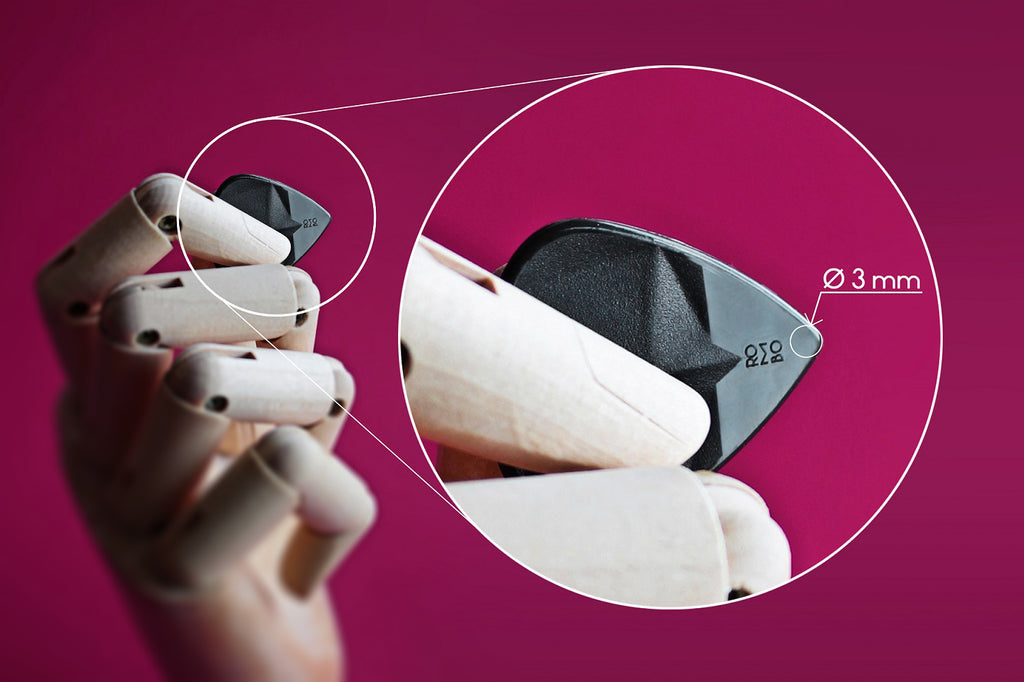
Tipp : Eine abgeschrägte Kante, auch Beveled Edge gennant, an der Spitze mit abgerundeten Kanten kann eine gleichmäßigere Saitenreibung fördern, was zu effizienteren Schlägen und Geschwindigkeit führt. Mehr zu diesem Thema weiter unten.
4.5 Gesamtgröße des Plektrums
Die Größe des Plektrums ist der wichtigste Faktor, wenn es um Komfort geht. Da keine zwei Menschen gleich sind, ist dies eine sehr persönliche Entscheidung. Außerdem ist dieser Punkt eng mit der Form des Plektrums verbunden.
Möglicherweise findest du es einfacher mit kleine Plektren zu shredden und schnell zu spielen. Deine Finger sind näher an den Saiten, sodass du besser spürst, was du spielst. Der Nachteil dieser Pleks ist, dass sie leicht fallen gelassen werden können, da ihre Gesamtfläche kleiner ist.

Oder du wirst vielleicht auch feststellen, dass größere Plektren einfacher zu halten sind und sich angenehmer in deiner Hand anfühlen. Sie können einen besseren Halt bieten, da mehr Kontaktfläche mit deinen Fingern vorhanden ist. Aufgrund des größeren Materialvolumens können sie deinem Ton jedoch viel Bass hinzufügen.
Experimentiere mit verschiedenen Größen, um herauszufinden, was für dich am bequemsten ist.
Normalerweise variiert die Größe zwischen 15 und 40 mm in der Höhe.

5. Andere Aspekte, die bei der Auswahl eines Plektrums zu berücksichtigen sind
Dicke, Material, Kopf- und Korpusform sowie Größe machen 80 % eines Plektrums aus.
Die verbleibenden 20 % können das Spielerlebnis jedoch viel komfortabler machen und dir bessere Ergebnisse und ein angenehmeres Erlebnis bieten.
Die folgenden Aspekte sind für Spieler, die das Beste aus diesem Gitarrenzubehör herausholen möchten, unbedingt zu berücksichtigen:
- Grip
- Abgeschrägte Kante (Beveled Edge)
- Variable Dicke
- Polierte Spitze
- Haltbarkeit
5.1 Grip
Die Griffigkeit, die ein Plektrum bietet, wird durch das Material, die Form, die Größe und die Oberflächenbeschaffenheit geschaffen.
Dies ist einer der umstrittensten Aspekte von Plektren, weil es ziemlich subjektiv ist. Während einige Spieler ein komfortables Pick ohne aggressive Texturen wollen, benötigen andere den maximal möglichen Grip, um sich sicher zu fühlen.
Äußere Einflussfaktoren wie verschwitzte Hände wirken sich ebenfalls direkt auf die Griffigkeit aus. (Wenn deine Hände beim Gitarrenspielen schwitzen, kannst du dieses Problem vermeiden, indem du die folgenden einfachen Schritte hier befolgst.)

In unserem Fall haben wir versucht, ein Gleichgewicht zwischen Komfort, Ton, Grip und Haltbarkeit zu finden. Beim Entwerfen unseres Grips haben wir Material und Textur berücksichtigt. Wir haben den Haltebereich unserer Picks mit variabler Dicke und 3D-Geometrien entwickelt.
Wenn du dich eingehender mit diesem Thema befassen möchtest, lies unseren Artikel mit dem Titel „ Griffigkeit von Gitarrenplektren verstehen: Grundlagen“
5.2 Abgeschrägte Kante (Beveled Edge)
Eine abgeschrägte Kante kann erstellt werden, wenn dein Plektrum dick genug ist. Das bedeutet mehr Geschwindigkeit und damit mehr Spaß!
Plektren mit beveled Edge sind die beste Option für Gitarristen, die dicke, spitze Spitzen verwenden möchten, die auch warme, fließende Töne erzeugen.
Plektren mit beveled Edge könne sich am Anfang seltsam anfühlen. Das Plektrum fühlt sich anders an: Es gleitet anders und das Feedback, das du von ihm erhältst, ist anders. Nach einiger Übung wirst du jedoch feststellen, dass einige Techniken tatsächlich viel einfacher sind.

Wir haben einen Artikel mit dem Titel „ The Guitar Pick: Bevel, Tip and Shape“ veröffentlicht, der die Beziehung zwischen diesen Attributen diskutiert.
5.3 Variable Dicke
Die Dicke des Plektrums ist wichtig. Was sind die Vorteile der Verwendung eines Plektrums mit variabler Dicke? Eigentlich sind es ziemlich viele.

Ein Plektrum mit variabler Dicke hat unterschiedliche Dicken für die Spitze und den Körper und wirkt sich auf die folgenden Aspekte aus:
Kontrolle: Ein weniger flexibler, dickerer Körper erhöht die Kontrolle.
Ton: Die zusätzliche Masse des Plektrums erzeugt mehr Basstöne und hat daher mehr Präsenz.
Vielseitigkeit: Da das Plektrum dünner als der Körper ist, können mit der Kontrolle über dicke Plektren adäquatere Techniken für dünnere Plektren verwendet werden.
Grip: Der dickere Haltebereich ermöglicht es den Designern, 3D-Geometrien zu erstellen, die den Grip ohne aggressive Grifftexturen verbessern.
Ein gutes Beispiel für eine solche Auswahl ist Rombo Diamond. Seine Spitze ist 1,35 mm lang, während einige Bereiche seines Körpers bis zu 2,65 mm dick sind. Die geneigten Flächen dienen als Stütze für Ihre Fingerspitzen.

5.4 Texturen auf der Spitze des Plektrums
Das Hinzufügen von Texturen an der Spitze des Plektrums kann Ton und Klang leicht verändern.
Die Oberfläche der Plektrumspitze kann sein:
- rau oder sehr rau mit Textur
- unbehandelt oder glatt
- poliert oder hochglanzpoliert
Wir haben uns entschieden, die hochglanzpolierte Spitze in unsere Plektren zu integrieren, weil sie Vorteile in Bezug auf Geräusch, Ton und Haltbarkeit bietet.
Ein Plektrum mit polierter Spitze verursacht weniger Reibung zwischen den Saiten und dem Plektrum, wodurch das Plektrumgeräusch reduziert wird und das Plektrum länger hält.

5.5 Haltbarkeit des Plektrums
Die Haltbarkeit wird von einer Reihe von Aspekten beeinflusst, wie z. B. Plektrummaterial, Form, Dicke und Stärke deiner Gitarrensaiten.
Langlebige Gitarren-Plektren sind perfekt für Spieler, die aggressive Techniken wie Shredden anwenden. Ich habe von einigen Gitarristen gehört, deren Plektrum nach wenigen Stunden weg ist!
Wenn du ein regelmäßiger Spieler bist, der gängige Plektrumtechniken mit weniger als zwei Stunden Übung pro Tag verwendet, brauchst du dir darüber keine Sorgen zu machen.
Als wir mit der Herstellung von Plektren begannen, war eines unserer Ziele, langlebige Plektren zu entwickeln, und wir haben dies durch die Verwendung einer verbesserten Version von Nylon erreicht.

Ein Punkt, der manchmal vergessen wird, ist, dass sich der Ton deiner Gitarre ändert, wenn sich die Plektren abnutzen. Die Beziehung zwischen Ton, Haltbarkeit und Verschleiß wird hier ausführlich beschrieben.
6. Tipps für Anfänger-Gitarristen
Gitarrenplektren mit mittlerer Stärke (Dicke zwischen 0,55 und 1 mm) sind am besten für Anfänger geeignet, obwohl die Leute dir sagen, dass du dünne Plektren verwenden sollst.
Du stehst am Anfang deiner Reise, daher können sich dein Geschmack, deine Vorlieben oder Gitarrentypen ändern.
Ein mittleres Plektrum gibt dir die Vielseitigkeit, die du am Anfang benötigst, und ermöglicht es dir, leichter zu dünnen oder dicken Plektren zu wechseln.

In unserem Artikel „ Medium Gauge Guitar Picks “ kannst du weitere Details zu diesen Plektren finden und entscheiden, ob sie zu deinem Profil passen.
Eine weitere gute Option ist ein Variety Pack, das unterschiedliche Plektren enthält. Dies ist eine gute Möglichkeit, mehrere Picks zu testen und deine Entwicklung zu verfolgen, während du nach und nach deine Fähigkeiten für jedes einzelne Plektrum verbesserst.
 7. Tipps für fortgeschrittene/fortgeschrittene Gitarristen
7. Tipps für fortgeschrittene/fortgeschrittene Gitarristen
Durch Ausdauer, Geduld und Disziplin hast du ein Gitarrenniveau erreicht, von dem viele Menschen träumen. Glückwunsch!
Der Gitarrenlernprozess ist eine Reise, und deine Ausrüstungsauswahl wird ihn erheblich beeinflussen. Gitarrenausrüstung macht dich nicht zu einem besseren Gitarristen, aber sie bringt mehr Spaß, mehr Kreativität und mehr Wissen in den Lernprozess.
Wir können es nicht oft genug sagen: Jeder Gitarrist sollte mindestens drei Lieblings-Plektren haben und vor allem wissen, warum.

Als erfahrener Spieler hast du wahrscheinlich viele verschiedene Fähigkeiten, die unterschiedliche Ausrüstung erfordern. Einige Phrasen eines Liedes erfordern beispielsweise warme Einzelnotentöne, während andere Lieder helle Töne und viel Lautstärke erfordern.
Wenn jeder Song unterschiedliche Anforderungen hat, warum immer das gleiche Plektrum verwenden?
8. Brauchen du Beratung?
Wir wissen, wie komplex Plektren sind.
Wenn du immer noch Schwierigkeiten hast, das richtige Plektrum auszuwählen, sende uns eine E-Mail über unser Kontaktformular und beantworte die sieben unten stehenden Fragen, und wir senden dir einen personalisierten Vorschlag. Wir versuchen, jede E-Mail in weniger als 72 Stunden zu beantworten.
- Spielst du E-Gitarre, Akustikgitarre oder Bass?
- Welche Musikrichtung spielst du?
- Bist du Leadgitarrist, Rhythmusgitarrist oder beides?
- Sind Sie Anfänger, Fortgeschrittener oder Fortgeschrittener?
- Wenn Sie ein fortgeschrittener Spieler sind, was sind Ihre Lieblingstechniken?
- Bevorzugen Sie helle oder warme Töne?
- Bevorzugen Sie flexible oder starre Picks?
Wenn du ein praktischer Mensch bist, probiere unterschiedliche Plektren aus und bilde dir selbst ein Urteil.
9. Letzte Gedanken zur Wahl des richtigen Plektrums

Es gibt tausende verschiedene Plektren und noch mehr Arten von Gitarristen. Die Kombinationsmöglichkeiten sind unendlich, und das macht Musik so schön.
Nicht nur die Harmonietheorie ist wichtig, damit ein Lied wunderbar ist, sondern auch die Art und Weise, wie es gespielt wird und wie es klingt.
Hier ist das Geheimnis: Es gibt kein richtiges Plektrum für dich. Es gibt Hunderte von ihnen, die dein Spiel auf eine Weise verändern könnten, die du dir nicht vorstellen kannst, also entdecke sie!
Ich wünsche dir das Beste auf der endlosen Reise des Experimentierens mit deiner Gitarre.

Medium Gauge Guitar Picks
Medium guitar picks are the most popular choice amongst guitarists and they offer the best of both worlds, right? Well, it is not that easy.

In our last article, “thin vs thick guitar picks”, we discussed both guitar pick thickness ranges in depth. Medium guitar picks deserve a separate analysis.
1- Why does guitar pick thickness matter?
Guitar pick thickness is usually measured in millimeters and this is an attribute that can change various aspects of a pick like flexibility, tone, volume, pick noise, durability, control over single notes, and more.

The thickness of a guitar pick is for this reason considered one of the 4 fundamental attributes of a guitar pick, along with guitar pick material, shape, and size.
2- Medium guitar pick thickness:
Medium guitar picks range in thicknesses from 0.55 and 1 mm.
The following is what a survey performed in March 2021 has shown. Thousands of guitarists were asked to define the following pick thicknesses:
- The maximum thickness of a thin guitar pick
- The minimum thickness of a thick guitar pick
With both limits established, we obtain the thickness definition of medium guitar picks.

The maximum thickness of a thin guitar pick was defined as about 0.55 mm by 2.292 guitarists.

The minimum thickness of a thick guitar pick was defined as 1 mm by 1.308 guitarists.
3- What is a medium guitar pick?
Medium guitar picks are guitar picks with a thickness between 0.55 and 1 mm. These guitar picks are very popular because of their versatility; in some areas, they offer the advantages of both thin and thick guitar picks.

Medium gauge picks have the broadest flexibility range. In this pick thickness interval, the material will play the most important role when it comes to defining the flexibility of a pick.
In other words, thick guitar picks are always stiff and rigid. With thicknesses over 1 mm, even the most flexible pick materials are stiff, and therefore the material has less influence on the flexibility of the pick. This relation creates a broad flexibility range amongst medium guitar picks, which can be very flexible or very stiff, depending on the material used.

The same effect can be applied to tone, durability, and pick noise.
Typically, medium guitar picks are used by lead guitarists who also implement rhythm guitar techniques and look not only for an all-round compromise between single-note melodic phrases and strumming, but also potentially developing a more versatile guitar career that integrates different techniques and mixes both worlds together.
4- Thin, medium and thick guitar picks:
|
|
Thin guitar picks (under 0.55 mm) |
Medium guitar picks (0.55 - 1 mm) |
Thick guitar picks (over 1 mm) |
|
Flexibility |
Flexible/very flexible |
Medium flexibility or stiff, depending on the material. |
Rigid/very rigid |
|
Tone |
Lighter tones, less bass |
Warm tones for softer materials. Brighter tones for harder materials. |
Warm/dark tones and mellow tones |
|
Volume |
Maximum volume is limited. Lower dynamic range. |
Can provide high volume with the usage of hard materials. |
Provide high volume. Broader dynamic range. |
|
Guitar pick noise |
Noticeable pick noise |
Reduced pick noise when the pick has a variable thickness. |
Reduced pick noise |
|
Durability |
Less durable |
Depending on the material. |
More durable |
|
Control |
Less control for single notes |
Very versatile. Control of single notes is possible if the player is experienced with this type of pick. |
High control of single notes |
|
Popular techniques |
Rhythm guitar, strumming, tremolo picking, ... |
Very versatile. A combination of both thin and thick guitar picks is possible if the player is experienced with this type of pick. |
Lead guitar, shredding, sweep picking, ... |
|
Common type of players |
Beginners, acoustic guitar players |
Most popular thickness. Medium thickness is used by beginners, intermediate and advanced guitarists. |
Intermediate and advanced guitarists |
This makes medium gauge guitar picks the most difficult picks to estimate without having tested them, and it is one of the reasons why we created the “guitar pick parameters” included in every product page, like in Rombo Origami.

5- Medium guitar picks are the best picks for beginners:
For most beginner guitar players, medium gauge guitar picks are the best option. You are in a process in which experimenting with sounds and learning new techniques will shape your profile as a guitarist in the future.
You might change your music taste during this process or even change your guitar type. You must stay flexible and versatile to allow your skills to develop in all directions and be a more rounded guitarist.
For this, a medium guitar pick is perfect, since you will be able to try different techniques with a pick that works very well in many different areas. After you have decided the direction of your development as a guitarist, increasing or decreasing the gauge won’t be that difficult.
Therefore, this is statistically the best option to start with if you want to try different guitar learning paths.

However, there are some exceptions: Some beginner guitarists know exactly what kind of player they want to be. They know from the very beginning if their dream is to become a very technical metal player, if they prefer being an expert acoustic guitar rhythm player, or if they will focus on songwriting and not on their guitar skills.
These examples are very rare, but they exist. In this case, you might want to consider starting with a guitar pick that has been designed for the type of skills you want to improve.
If you are a beginner, this might be interesting for you: Guitar pick for beginners
6- Medium guitar picks at Rombo
Rombo Origami guitar pick - 0.75 mm
Flexible but still rigid enough for note control. Right amount of flexibility for a snappy fluid attack that's bright and crisp. The concave surface on the hold area ensures ergonomic and comfortable hold.

Rombo Prisma guitar pick - 0.8 mm (available in September 2021)
A classic shape enhanced by modern surface technology. The geometry on the main body has different height levels for the most comfortable hold and grip.

Rombo Crisp guitar pick - 1 mm (available in September 2021)
Medium thickness combined with geometric concave design surfaces. The result? Unexpected flexibility with great bass tones. Its medium-sharp tip provides extra warm tones.

7- Conclusion on medium guitar picks
Each pick has a specific purpose, and you choose the pick based on the sound you want to achieve as well as other personal preferences like comfort and grip.
Medium picks are not just the picks in the middle of thick and thin guitar picks. They are a perfect approach for those guitarists looking to develop versatility and flexibility in their learning path.
Due to the high influence the material has on these picks, they are the most difficult picks to estimate before testing them, and every medium guitar pick is unique. Despite this, they are the best choice for most beginner guitarists.
However, if you have a very clear idea of the skills you want to develop in the future, you might be looking for either thin or thick guitar picks, which we discussed here.

Thick Guitar Picks vs Thin Guitar Picks
Thin guitar picks vs. thick guitar picks. This eternal battle has been a part of every guitarist's conversation for decades. It is time to finally evaluate both alternatives in depth.
The thickness of a guitar pick is generally measured in millimeters, and it is an attribute that influences many physical aspects like tone and flexibility. For most players, this is considered the most important attribute when choosing the right guitar pick.

However, after doing some online research, nobody seemed to really know how thick a guitar pick needs to be to be considered as a thick or heavy guitar pick. Where is the line?
Therefore, the first thing we did was to create a big online survey on our Instagram guitar community.
1- What are considered Thick Guitar Picks? Thoughts from the Guitar Community
The survey we created was online for 24 hours on an Instagram story and the participants were asked to answer two simple questions.
Personal preferences - thick picks or thin picks?
This question was the first one, and its aim was to see if guitar players prefer thick or thin guitar picks. Here are the results:

It seems that over two thirds of the guitar players prefer guitar picks considered as thick. Honestly, I thought there would be a 50-50 relation and this surprised me a lot.
What do you consider as a thick guitar pick?
This was the second question, and the guitar players could select different thicknesses they considered to be the “least thickness needed for a guitar pick to be considered as thick or heavy”.

The results showed that on average, a pick must be at least about 1.0 mm to be considered as a thick guitar pick.
These results are very interesting, since the information we found during the research claimed that a pick is considered as “thick” or “heavy” if it surpasses 0.8 mm thickness. We did not find any study or survey with more participants than ours.
Of course, we have to consider that we do not have any way to track more specific characteristics of the participants like skill level, music preferences, guitar type, age, and so on.
Average thickness of guitar picks over time
Additional research on this topic showed that during the past decades, the average thickness of the guitar picks has increased substantially. Thin guitar picks are even considered as vintage by many players due to the tone they produce.
This is no surprise, given that most modern guitar techniques and effects that require thick picks (like shredding) were non-existent during the 1950s and 1960s.

2- Why does guitar pick thickness matter?
The thickness of a guitar pick is one of the most influential attributes.
The guitar pick thickness influences:
- The flexibility of the pick
- The tone produced by the pick
- Volume and body of single notes
- The pick noise created by the pick
- The durability of the pick
- The control over the pick
- The feedback you will receive from the pick
A minimal change in the thickness of a guitar pick of only 0.2 millimeters (equal to two common paper sheets) is enough to change the properties of a guitar pick drastically.

3- Thick guitar picks vs. thin guitar picks:
Let's pretend there are no medium guitar picks and create a clear line that divides both thickness ranges, to make the differences between thick picks and thin picks more appreciable.
|
|
Thick / heavy guitar picks |
Thin guitar picks |
|
Flexibility |
Rigid/very rigid |
Flexible/very flexible |
|
Tone |
Warm/dark tones and mellow tones. |
Lighter tones, less bass. |
|
Volume |
Provide high volume. Broader dynamic range |
Maximum volume is limited. Lower dynamic range |
|
Guitar pick noise |
Reduced pick noise |
Noticeable pick noise |
|
Durability |
More durable |
Less durable |
|
Control |
High control of single notes |
Less control for single notes |
|
Popular techniques |
Lead guitar, shredding, sweep picking,... |
Rhythm guitar, strumming, tremolo picking |
|
Common type of players |
Intermediate and advanced guitarists |
Beginners, acoustic guitar players. |
Thick picks: Summary
Thick guitar picks will provide mellower/darker tones. The common rounded edges that can be manufactured with thicknesses over 1 mm – combined with their rigidity – increase the bass tones and the volume these guitar picks can provide, while reducing the pick noise the pick produces.
These picks provide more control over single notes and are usually the best option for lead guitarists.

Most advanced guitarists prefer thick picks, because in their guitar journey they develop new guitar techniques that can be performed better using this kind of picks. Thick plectrums provide more control when it comes to single notes and complex guitar pick techniques like pinch harmonics.
One of the biggest advantages of using heavy picks is the durability they provide. Nevertheless, the lifetime of a guitar pick is influenced by many other aspects, as we learnt in the article “Durability of a guitar pick”.
Thin picks: Summary
Thin picks are the best option for guitarists looking for brighter tones, especially using acoustic guitars and some strumming techniques on electric guitar.
The flexibility of these picks limits the maximum volume that can be achieved. This can be an advantage because it works like an analog limiter. This is especially helpful in a studio session, where the maximum volume achieved must be controlled.

Most beginner guitar players start using thin picks because their guitar skill set at the beginning includes guitar techniques like strumming.
Note control can be difficult with thin guitar picks. However, some players use this attribute for specific guitar techniques, like in surf music, where a super fast tremolo picking is required.
4- Example of a thick guitar pick: Rombo Jade
Rombo Jade is the perfect example of a thick guitar pick. Thanks to its thickness, a very large bevel edge could be implemented to be as sharp as possible, providing the precision needed when using these kinds of picks.

The size is small, a typical attribute of thick guitar picks, and its shape ends with a very pointy guitar pick tip for maximum attack.
5- Example of a thin guitar pick: Rombo Classic
Rombo Classic is the thinnest Rombo guitar pick. In the middle, it is only 0.38 mm.
This guitar pick is extremely flexible and has a medium/large size with a standard 5 mm diameter guitar pick tip.

In spite of its thickness, the dynamic range of the pick is great. This is caused by the material used in our picks.
6- The right guitar pick thickness for you
I am sure you already have an idea of your favorite guitar pick thickness. In case you don’t, it is probably because you are at the beginning of your guitar journey.
Is there a wrong guitar pick thickness to play guitar? Any pick you use to get sound out of your guitar can work, if the sound produced is the sound you are looking for. It is entirely a matter of personal preference.
If you are a beginner guitar player, I recommend you start with something like 0.75 mm, as I described here: "Guitar Picks for Beginners"
However, if you are an intermediate player trying to find a way to discover new guitar tones, I do not have better advice than to tell you to try many different thicknesses and start integrating other important aspects of the guitar pick in your decision, like materials, size, shape, etc...

The good news is, you will probably end up having 3 to 5 favorite guitar picks which you can use for different techniques. So, enjoy the journey and be open to experimenting with different tones and textures with your guitar!
7- Current guitar pick thicknesses at Rombo:
For this chapter I included the new guitar picks, which will be officially released during 2021.
As you can see on the thickness scale, there are still some slots missing (for example something like 0.6 mm), we will be filling them in the future, as we design new guitar picks.

However, we might repeat thicknesses if other aspects change a lot, for example the shape, the sharpness of the tip, the size of the pick, or other grip textures.
8- Variable guitar pick thickness
Another important factor to consider is that some picks do not have constant thickness along its design. But why?
As we did our research back in 2018, we found out that designing guitar picks with variable thickness comes with many advantages.
Let's take Rombo Origami as an example: The guitar pick tip is 0.75, but its hold area is thicker. This simple change makes the pick produce darker and mellower tones without losing much of its flexibility.

In the case of Rombo Diamond, the middle area (where all vertices collide) the thickness goes up to 2.65 mm. We increased this area after experiencing that the relation between the thicknesses along the guitar pick also increases the control over the pick for single notes.

In addition, with more thickness on a given material, you have more possibilities to introduce design elements, like the 3D geometries we use in our picks. These geometries have two positive effects: on one side, they enhance the grip of the pick because of the tilted surfaces, and on the other side, the guitar picks look very cool!
In short, variable thickness will make your picks more versatile and give you extra control.
9- Conclusion
Thick picks vs. thin picks will remain a hot, trendy topic in the guitar community.
However, if you are already an intermediate player with some knowledge about equally important aspects of a guitar pick like shape or material, spread the word to avoid confusion among the newcomers.
We have already discussed the huge variety of different guitar picks you can find online in our article “Guitar picks online” since this can be overwhelming for some beginners.
The best advice I can give you: love both thin and thick picks and try to understand why they are different. Both need to exist in a world where creativity and different tones and styles are needed!
Now it’s your turn, what is your favorite guitar pick thickness?

Understanding Guitar Pick Grip: Essentials
The grip of a guitar pick is one of the most controversial topics when it comes to guitars.
Different materials or shapes of guitar picks make this topic as interesting as confusing to many guitar players.
Everyone is different and everyone plays differently. However, we (guitarists) have the same goal in this area: have a decent guitar pick grip and play as comfortably as possible.

1. What is Guitar Pick Grip?
Grip is defined as “a firm strong hold”.
The grip of a guitar pick should be good enough to avoid the slipping of the pick, the turning of the pick, or (worst case!) the dropping of the pick. In addition, it should be able to give you enough flexibility and freedom to change the position of the pick when needed.
The grip is mainly caused by the material and the texture of the surface. Nevertheless, there are other aspects like overall size or 3D geometries that can substantially increase how firmly a guitar pick can be held.

2. Advantages of Guitar Picks with high Grip
Guitar picks with a high grip can help to keep your pick from slipping. These guitar picks “stick” to your fingers even when you play aggressive guitar techniques.
They are also known for providing a feeling of secure hold and control. Your hand will need less tension to hold the pick and this will help to relax your muscles.
We have already discussed how important it is to have relaxed muscles when practicing guitar in our article “7 easy warm ups every guitar player should know”.

The biggest advantage is their usage in live performances, where control and security is essential to play correctly every chord. However, they can still drop and get (instantly) lost. Therefore we suggest having a couple of extra picks with quick access somewhere on the stage or to use a Guitar Pick Holder.
3. Disadvantages of Guitar Picks with high Grip
Although guitar picks with high grip feel very secure, this feature often comes with some disadvantages. The aggressive grip surface can feel uncomfortable or even damage your skin. This is a common problem for professional guitarists training over 2 hours a day.
The high grip sticks to the fingers and this eliminates some of the freedom you have when moving your pick on purpose, for example when you change its position to execute pick slides or harmonic pinches.
4. Types of Grip Textures on Guitar Picks
Depending on the type of guitar you play, your music style and techniques, or how sweaty your hands are when you play the guitar, you will need a different type of grip texture.
These are the most common grip textures on guitar picks:

Guitar Picks with Sandpaper Grip:
Maximum grip. Very aggressive texture. Can be uncomfortable for long playing sessions.
Guitar Picks with raised Geometries or Logos:
High grip. Aggressive texture. Can feel uncomfortable for long playing sessions.
Guitar Picks with Micronodules Texture:
Medium grip. Comfortable texture and adequate for long playing sessions.
More information about this grip texture can be found here.
Grip Holes or deepened Geometries:
Medium grip. Sometimes uncomfortable when holding the pick very tight.
Homemade Guitar Pick Grip:
Some players use tape or make scratches on the pick surface to create a custom experience.
5. Less common Ways to increase Grip on Guitar Picks
As mentioned before, not only material and textures can create grip on guitar picks. There are two factors that are usually unknown and can be very helpful to increase the grip.
Using Guitar Picks with 3D Geometries on the Hold Area:
3D geometries are an underestimated way to increase grip on guitar picks. The concave and convex surfaces will create a very defined position of the guitar pick and avoid the turning of the pick without the drawbacks of aggressive textures.
In addition, correctly tilted surfaces will use your fingers as support or pivots when moving the pick on purpose.
At Rombo, we believe this is the future of guitar picks and we are increasing our efforts in this area.
One very visible example of this is Rombo Crisp.

Using a larger Guitar Pick:
The shape and size of a guitar pick are essential to increase the grip. The larger the surface, the more contact it will have with your fingers, and therefore the more friction it will create.
The best example for this are bass players that use picks. The strings of the bass are very thick and with every impact, the pick must be held very firmly. Most bass players use big sized triangle picks or teardrop picks with enough surface on the body.
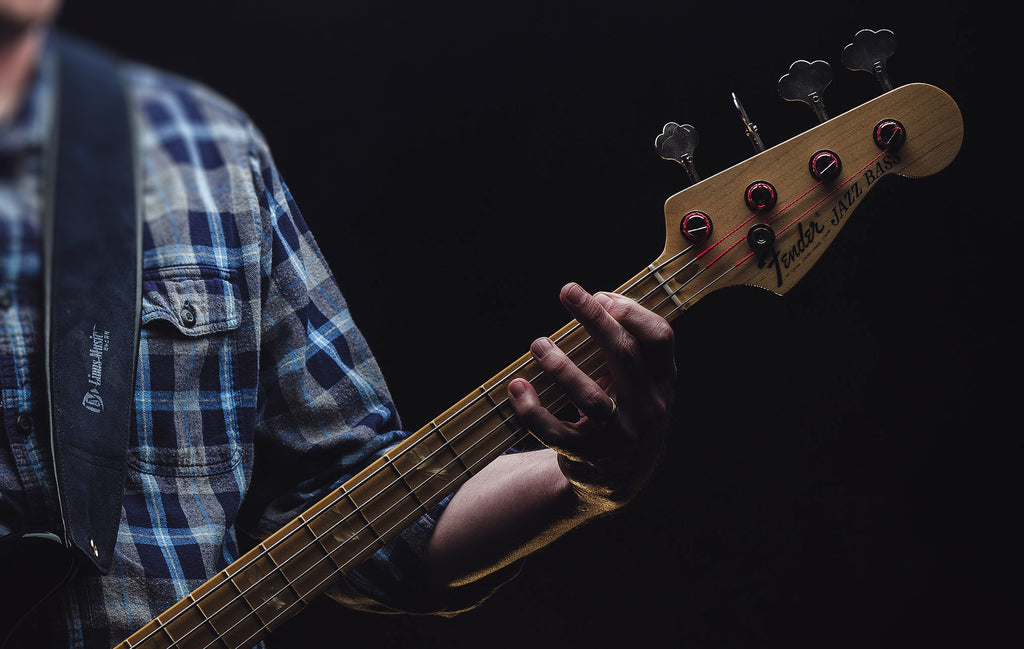
Holding your Guitar Pick right:
This is an external factor and not intrinsically dependent on the guitar pick. However, I decided to include it because of the number of players having trouble with this issue and not being aware of it.

If you feel you cannot hold the guitar pick firmly and some techniques make the pick slip or drop, you should question how you hold a guitar pick before you question the grip provided by the pick.
For these people, we created an article called “How to hold a guitar pick”, which can be found here.
6. Guitar pick Grip at Rombo
The absolute guitar pick grip of our picks is determined by four factors:
- Material
- Micronodules grip textures
- 3D geometries
- Variable thickness
The combination of these factors creates a medium-high grip, which is still comfortable enough for long playing sessions and adequate for live performances.

When developing the grip, our focus was to create a type of grip which allows the player to keep enough flexibility and freedom, as well as providing a high feeling of security and control.
With the material, we made no compromises and chose a very improved version of nylon manufactured in Italy. We have discussed its properties here.
7. The adequate Guitar Pick Grip for you
It is up to you to find a balance between comfort and grip. Some players prefer non-sticky guitar picks, others need the maximum grip available.
Depending on your playing style, your hours of practice, and the environment (solo, studio, live, ...), you might need different guitar pick grips for different occasions.

Personally, I put comfort at the top of my priorities when it comes to guitar playing. Once I get used to a guitar pick, the grip is a secondary aspect to take into account. If I choose a comfortable holding I can put my attention on other aspects like tone or attack.
8. Conclusion and last Thoughts
There are many different levels of guitar pick grip depending on the material, the textures, the size, and other secondary aspects.
The greatest guitar players use different picks for different occasions or instruments, and we recommend having at least 3 favorite guitar picks to vary things like tone, attack, grip or flexibility, and become a more versatile guitar player with the ability to adapt yourself to different environments.
Choosing the right guitar pick grip is a journey every guitar player will experience. I hope you enjoy the journey and try lots of different and interesting types of guitar picks!


Inside Rombo Guitar Picks: Guitar Picks developed and engineered in Germany
This article was created because you asked for it. It is meant to be as transparent as possible, so that you can see who the faces behind Rombo are and how we organize this project internally.
We hope you enjoy it!
Rombo Guitar Picks: Short Introduction
Since 2019, Rombo has been researching surface finish and design in order to find the perfect balance between grip, ergonomics, and function in guitar picks and other guitar accessories. Rombo was born thanks to an amazing guitar player community whose aim is to continue this adventure and quest for the perfect guitar accessories.
Who are the faces behind Rombo Guitar Picks?
We are Judith and Carlos, a happily married couple trying to innovate in the world of guitar picks. We live near Stuttgart, Germany.

We both love music, guitars, product development, challenges, and attention to detail, so Rombo was the perfect excuse to mix all these things together and have some amazing adventures.
Our location in Remseck a.N., Germany
Packing and shipping of our guitar picks
From Remseck, near Stuttgart in Germany, we do almost everything.
Here, we receive the packaging and the dots we use to fix the guitar picks to the packaging. We try to be very organized and keep the place very tidy. Tidy places also look better for photographs!

In the shipping station, there is one tray for every guitar pick model. We also include a flyer and a “thank you”-card with every delivery. This way we make the experience more personal, while sharing our journey of packing your guitar picks directly with you!

We have a label printer, which is super useful, and thankfully our web system allows us to automate the printing for every customer and create a label with just one click.
Our post carrier receives the boxes from us with all the information they need to bring our products to you, including weight, countries, and import information for the customs.

We ship every order directly from our location.
The envelopes we use are not very cheap, but they protect the product well, they are made of 100% recycled paper and they are plastic free.

Always learning something new
We have to be very multifaceted to cover all the tasks we do, from idea generation, product development, graphic design, photography, web maintenance, logistics, social media, packaging development, and accounting, to all the stuff a start-up involves.

We believe that doing everything by ourselves gives us a very close perspective from the customer side.
This means, when you ask something on Instagram or Facebook, you receive an e-mail from us, or we answer your comment. It is us behind the screen typing every word and every smiley!

We love walking a lot. We go for a walk for 5 kilometres almost everyday. Almost every idea we applied to Rombo was created while having a walk. We called it our daily inspiration walk.

Rombo is a long journey
Two years ago, at the very beginning of this journey, we could not have imagined how many things we needed to learn!
We have encountered many challenges on the way; for example, I remember it was very difficult to find out how to sell internationally and establish a system that is fast enough for us.

I cannot tell how many books on startups, online marketing, Kickstarter or time management we have read! One of the most useful ones was A Crowdfunder's Strategy Guide: Build a Better Business by Building Community, by Jamey Stegmeier.
A funny anecdote is that Judith and I don’t have our own Instagram profiles. For the first post from Rombo, we had to check out a tutorial on Youtube to try to understand the process. I am glad to say that two years later, we have reached almost 20K followers!
PS: We still don’t have our own accounts, the one for Rombo is enough work! :)
Guitar picks: All about the design process
The most complex part is the design process of a guitar pick.
I like to sketch a lot, so I have lots of old ideas and sketches which I use as an inspiration source. Sometimes, we use questions to challenge the design process, like “Is it possible to create a guitar pick that is flexible and rigid at the same time?” While trying to answer this question, we came up with the idea of “variable thickness”, which has proven to substantially increase ergonomics.

Since we have an engineering & design background, we also do the modeling in 3D and product engineering. Every detail is important here to create high-quality products.

When we think the design is ready, we create some prototypes and send them to the testers. If you follow us on social media you will know some of the testers from our stories.
In total, we have about 30 guitar players that help us during this phase of the project and communicate with us which points they liked or didn’t like. Thanks to their feedback, we are able to improve areas of the guitar picks which we would otherwise not have thought of.
Manufacturing technologies
For the manufacturing of our guitar picks on a large scale, we use a technology called injection molding.

In this process, the melted raw material is injected into a mold with the negative shape of the guitar picks.
It is a very complex process with lots of engineering in it, the material has to be treated in a special way to keep the proper humidity, temperature and pressure, and to avoid external contaminations.

On the left, the injection mould from Rombo Diamond: Our polimer flows through the mould runner (yellow arrows) after it reaches over 270°C degrees and it is pushed forward.
The red area is the area we use for the grip texture. The blue area is high mirror polished.
On the right: The first ever produced Rombo Origami from 30.11.2018. The first 50 guitar picks we produced were sent to guitar pick testers who gave us feedback about the material, the grip, the tone and the shape.
The raw material we use is produced in Italy. We have worked very closely with our material partner to accomplish every requirement we had, including the 100% recycled material of the EcoBlack sets. If you want to know more about the materials we are using, you can find more information HERE.

Packaging for guitar picks
We believe packaging is a very important aspect of a product. We not only use it to create an atmosphere and emphasize the quality of the product, but also to inform you about the attributes of our guitar picks.

This is the reason we created packaging with lots of printable areas to describe the guitar picks. We include our parameter bars, a short description of the guitar pick, the 6 special attributes of a Rombo guitar pick, and a QR-code with extra information.
We had a total of about 6 different concepts before we decided which one was the most suitable.
Right now, we are creating the packaging layouts for the new models that will launch in 2021. We have received some samples and they look great!


If you want to see the new models, you can click HERE.
Guitar picks and social media:
Rombo product photography:
Carlos takes the pictures for social media. We are not very skilled with the camera, but we have learned a couple of tricks and after thousands of trials, we are able to take decent pictures in our living room.

In our Instagram you can find the best pictures.
Educating the customer
You have probably noticed that our posts on Instagram are mainly informative. Guitar picks are often underrated and most guitar players don’t think much about it.
However, guitar picks are the loudest amplifier you can have in your hands and are the bridge between you and your guitar.

We try to pass the know-how we have obtained directly to you, so you can make conscious decisions about the products you purchase. Aspects like the variations on the tone depending on guitar pick thickness, or why are there so many guitar pick shapes and materials… And this is the reason we created our blog articles.
Our aim is to create a communication process that goes back and forth between us. Some of you have become friends of ours and have won a new perspective of thinking about guitar picks.
Engagement of the community
“To listen closely and reply well is the highest perfection we are able to attain in the art of conversation.” – François de La Rochefoucauld, essayist.
We believe we have one of the most engaged communities ever! We try to answer every comment and every private message, and we are sure we have an answer rate very close to 100%.
You all have participated in surveys, and you have left amazing comments and reviews. You post stories regularly and we have had very deep conversations with some of you! Thank you!
We also received great support from many amazing blogs like Heavy Repping, Gigs and Guitars, The Gadget Flow, Ultimate-Guitar, Guitar World, and others.
Rombo around the world
Rombo is expanding. We are working with dealers around the world and currently we have sellers in the following countries:

This means, with the help of our dealers we are able to sell in Europe, North America, Asia, Australia, almost every country of South America, and South Africa.
Transparent communication with our dealers is a priority with us, and so far 100% of the new sellers stay with us! Together we are developing the brand and taking it to the next step.
The future of rombo:
During our inspiration walks, we talk about Rombo in the next few years. It is very difficult to imagine what the future will bring.
We would like to bring new designs (lots of them!), to increase the amount of recycled material for the manufacturing of the picks, or even be able to create colored recycled guitar picks. We want to talk more to our customers and share our experiences, and from time to time, share some great music and playlists.
We are only two people and every step takes its time. Some of you have written beautiful thank you letters to us or left very good reviews and we want to let you know that we are working hard everyday not to disappoint you :)
You are the best and you have a vote on the future of Rombo!

New guitar picks for 2021 - How over 1500 guitar players helped us co-design our guitar picks:
In May 2020, Judith and I had finished the first 3D sketches of our four new guitar pick models. However, the picks weren’t 100% ready.
The thickness, the size, and even the names of the picks were still undefined.

We decided to take a new approach and involve as many guitarists as possible to help us co-create our new guitar picks.

What is a signature guitar pick:
Signature guitar picks are common in the guitar pick world.
These picks were developed with the help of some expert and famous guitarists from a specific music field.
From our point of view, this is a very narrow design path that only considers the opinion and guitar playing style of one person.
Our approach: The opposite of a signature pick:
The guitar community has strongly supported Rombopicks since its beginning in 2019.
We did not want to create new guitar picks without asking the people who have been with us since the beginning. You guys and girls are the core of Rombo, and you should decide which products we develop.
The most logical step was to create a big survey to allow users to tell us how they prefer their guitar picks.
We think this is the only way to develop our guitar picks, based on the wants of our users, allowing us to make essential decisions about our company's direction.

This is only possible by listening to the thoughts of every guitar player.
In addition, by asking precise questions about guitar picks, we are able to create more awareness of complex issues, like: Why are guitar picks thick or thin? How they behave when the size changes? Does the flexibility of a guitar pick affect the tone? What about the material?
When the user is aware of the product features, he/she can deliver a useful vote.
Since the beginning, we have been researching all these areas and are sharing them with you. With every article about plectrums we have written, we have contributed to the knowledge you have about your gear so you will be able to decide which gear is the best for you and understand why.
The results of the survey:
Participants:
1.552 guitar players (including us) have participated in the survey and therefore have took part in the design process of these new guitar picks for 2021.
336 of them left a private message with detailed information.

What is your favorite guitar pick design?

Pick number1: 18,8%
Pick number 2: 14,8%
Pick number 3: 27,8%
Pick number 4: 38,7%

Guitar Pick Number 1:

Name:
Rombo Horizon: 34,5%
Rombo Sense. 33,9%
Rombo Summit: 14,1%
Rombo Mood: 7%
Other names: 10,5%
Average Thickness: 1,378 mm
Average Size: Medium Size with 71% of the votes
Guitar Pick Number 2:

Name:
Rombo Prisma: 76%
Rombo Spin: 7,7%
Rombo Treble: 8,4%
Other names: 7,9%
Average Thickness: 0,831 mm
Average Size: Large Size with 73,5% of the votes
Guitar Pick Number 3:

Name:
Rombo Crisp: 47%
Rombo Split: 22,1%
Rombo Prisma: 16,4%
Other names: 14,5%
Average Thickness: 1,028 mm
Average Size: Medium Size with 59,7% of the votes
Guitar Pick Number 4:

Name:
Rombo Jade: 33%
Rombo Shift: 17,6%
Rombo Slope: 12%
Rombo Summit: 10%
Rombo Dune: 7%
Rombo Cascade: 7%
Rombo Wizzard: 4,9%
Other names: 8,5%
Average Thickness: 2,37 mm
Average Size: Small Size with 56,6% of the votes
Guitar picks: Personal thoughts of 336 guitar players

A total of 336 people left us a private message regarding guitar picks.
We have read all of them carefully and we will use all this information during the development.
Here are the important questions we have received and our comments to them:
-
Will the guitar picks be available in new colors?
Not at the moment. However, we are thinking about creating some additional colors for special editions in the future.
-
Will they have the same grip structure?
Yes! Definitely. Lots of people have sent us e-mails and letters regarding the grip structure. With the micro-nodules, we have the advantage of medium-grip surfaces which add lots of control.
However, a very small number of people want the picks to have more grip. We had to make a decision here, and it was hard.
We won’t forget this topic: In the future, we want to develop a texture with more grip for these players.
-
Why don’t you create different guitar pick thicknesses for each one of the models?
We want every guitar pick to be unique. As every person has unique preferences, we believe every guitar pick should have its own design.
In the future, we hope to be able to create a bigger quantity of different plectrum designs to cover each possible necessity.
-
What about picks for bass players?
Most our picks are compatible with bass, as we have confirmed this with some bassists that are using them regularly, especially Rombo Diamond ad Rombo Origami. We explained this HERE.
-
You should create some merch, T-Shirts and other stuff:
Maybe in the future. Now, we want to focus 100% on the development of the guitar picks. Every minute we spend on the design of a T-Shirt will be taken away from the quality of the picks! ;)
-
Will you offer the EcoBlack range in other colors?
The EcoBlack material can only be produced in one color at the moment. The recycling process creates a very dark pigmentation. The industry is working hard to find a way to create new recycling processes. We hope we will manufacture all of our picks out of recycled material in the future.
When will be the new picks available?

The new guitar picks will be available in early 2021.
If you want to receive an E-Mail as soon as the picks are availabe, join our mailing list below on the footer.
This is the timeline we created for this project:
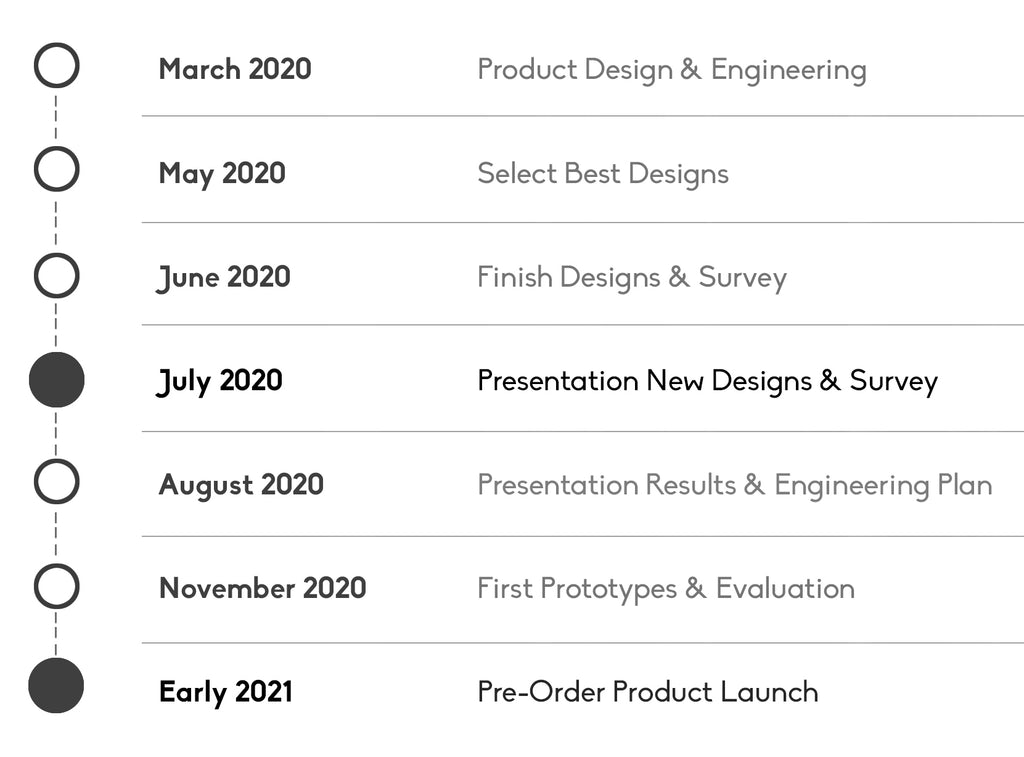
The pre-order product launch will be on the platform Kickstarter (like the first generation of Rombo guitar picks we launched in January 2019).
However, the current development of the Covid-19 could postpone the project a couple of months. We want to launch the product when we are able to deliver worldwide.
Why Kickstarter?
Kickstarter campaigns turn dreams and ideas into reality. Rombo is still a small start-up run by two people, and with limited access to resources. Through Kickstarter, we involve the community of guitar players, showing our guitar picks before launching.
This process brings us in contact with the real guitar players and their necessities. It forces us to remain flexible, accept changes, and challenges us to create new designs to fulfill the expectations of our audience.
We love open and critical criticism, and this is the best place to get it, where all comments and thoughts are visible. By sharing your experiences, we can listen to your needs and wishes, and create guitar picks that make a difference.

Guitar Pick Durability: Everything You Need To Know
The guitar pick has been in constant evolution since the 1920s.
Today, 100 years later, we have achieved great accomplishments in the area of durability of this very important piece of guitar gear.
In this article, we will review all the important points that can cause picks to wear out, and summarize all you need to know about guitar pick durability.
We will make some comments on the tone, to help control the changes, which happen after a guitar pick has worn down.
In addition, we will give some advice to keep your picks “healthier“, longer than expected.
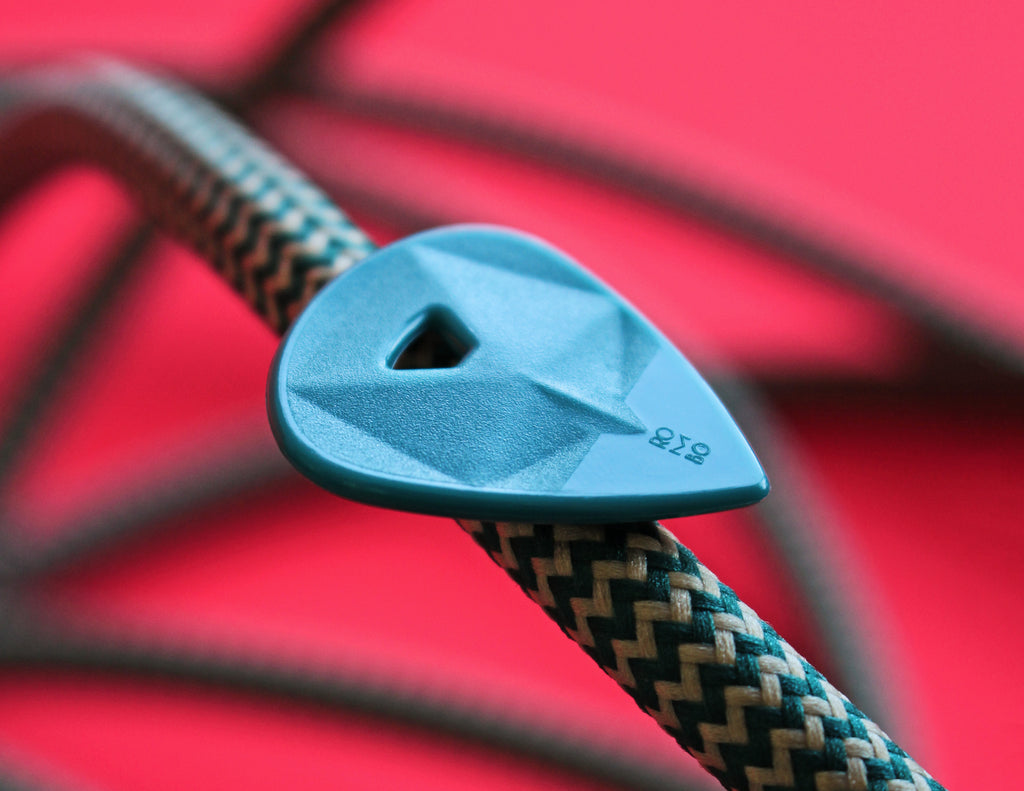
New vs. Old (worn down) Guitar Picks: Tone Changes
We all know that using different guitar picks, will also make a difference in your tone, and your playing. Material, shape, thickness and shape of the pick, directly affect the tone and playability.
Most standard plectrums can resist heavy strumming for a long time, without much wear and tear.
The first thing you may notice after using a guitar pick for some weeks, is that the tip is not as pointy as the new guitar pick. You will see it, and you will hear it, because the tone of the pick will change over time, with wear.


The rounded shape of the worn down plectrum, will create warmer tones, and feel darker. This is totally fine, if this is the tone you are looking for.
It will also affect the way your plectrum plucks the strings:

Just like the guitar strings, the frets, & other components, the guitar picks will wear out over time.
Some players feel a lack of control after the guitar pick has worn down, while others use the rounder picks because of the tone they produce. This especially happens to jazz guitarists, who tend to choose picks that are almost circular, for example: Rombo Waves.
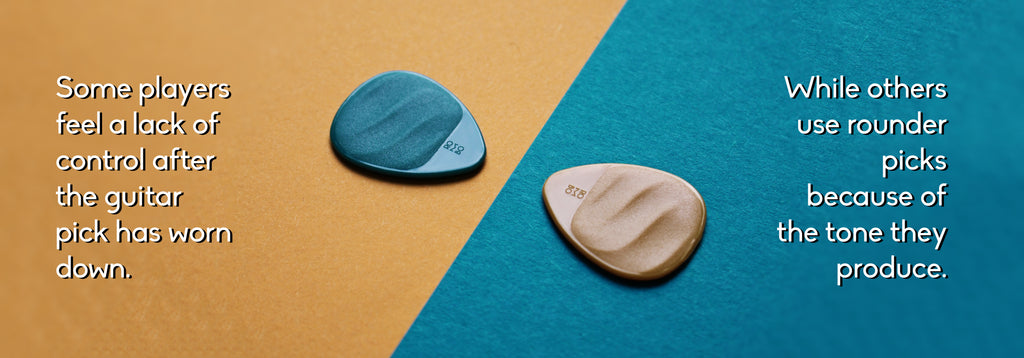
Gaining control when using rounder guitar picks, is an ability you can train yourself to do, and improve.
Why Can’t Picks Last Forever?
Guitar strings are usually made from a mix of steel, nickel, bronze, or brass. In other words: Metals.
Since most players use some kind of plastic material for their guitar picks, (nylon, delrin, …), it’s not surprising that friction between strings and picks will cause the guitar picks to wear down.
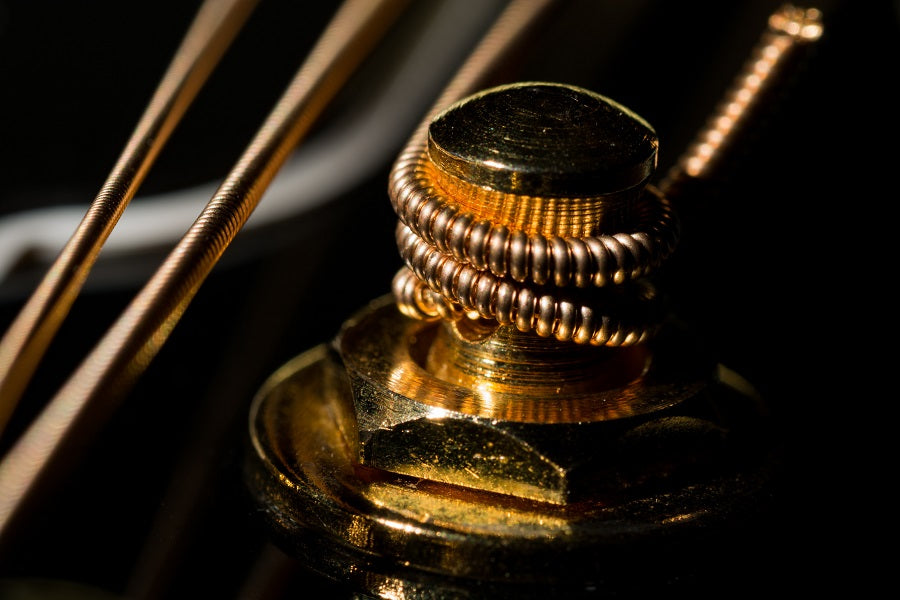
You will notice, the thickest guitar strings have a spiral wire wrapped-around, acting like a sanding file on the plectrum.
Guitar Pick Durability: How Long Should a Guitar Pick Last?
The short answer: If you are an average user, your picks should last a few weeks to a month. If you are a professional player, using specific techniques, like heavy picking and strumming, it will probably last just one day, especially if you are a studio musician recording new tracks every day.
The long answer: This answer includes many factors including guitar pick attributes, and external factors, regardless of the guitar pick you are using. We discuss all of them below.
Guitar Pick Attributes That Directly Affect the Durability
The attributes that define the durability of a guitar pick are as follows:
- Guitar Pick Material
- Guitar Pick Thickness
- Guitar Pick Tip Shape
- Guitar Pick Tip Texture
Harder materials will wear down slower. This is one of the reasons there has been a lot of research in the area of suitable materials for guitar picks.
The goal is to find a wear-resistant material, that keeps the tone characteristics that guitar players want, while still giving a good grip.
However, material is not all. The thickness of a guitar pick will enormously affect the wear and tear. Thinner picks will wear down almost immediately when using heavy pick techniques.

Other attributes of the pick that affect the durability, are the Tip Shape, and the Tip Texture. Very pointed guitar tips tend to wear down faster, because there is less material on the tip.
However, this problem can be partially solved with the right guitar pick tip texture. A polished tip on the guitar pick will cause less friction between strings and plectrum. This is one of the most underrated attributes of a guitar pick, and you can find more information HERE.
What Damages the Pick the Most?
Results show, that the best way of altering and degrading the shape of your plectrums is to perform “pick slides”.
This guitar technique will wear away the edges of your plectrum and will make it useless very quickly.
This won’t directly affect the tone or control of the plectrum, but the damaged sides will contain some dents. The plectrum will get stuck either on the up stroke or the down stroke.
External Factors Which Indirectly Affect the Durability
It’s not only the guitar pick quality that is responsible for its‘ damage. There are three more factors that can play a role on the durability:
- Hours of guitar training
- Guitar strings gauge
- Guitar playing style and used techniques
It is a very simple equation: The more hours you practice, the more your picks will get damaged.
Thicker guitar strings will increase the area of contact with your plectrum, and therefore, wear it down much faster.
Aggressive guitar playing techniques, like fast palm mute, or pick slides, will damage your guitar pick very easily.
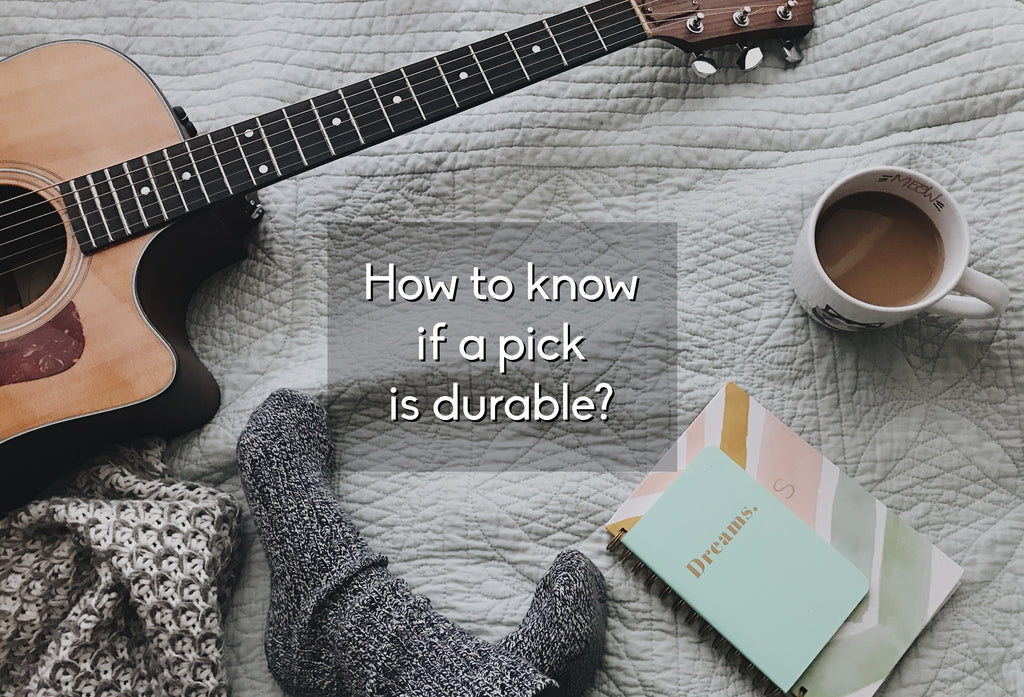
How to know if a Pick is Durable?
The best way to find out, is to test it, and make your own judgment.
You can take advice of expert players, who have tested lots of guitar picks. However, if their playing styles differ from yours, this information won’t help much.
Besides, many expert players have not changed their picks for decades, and they might be missing the material improvements of the last decade.
As mentioned, not only is durability a factor to take into account when choosing a guitar pick, but also the tone and the ergonomics (grip, size,...).
How to Know When to Replace Your Pick?
If the edges of your pick are becoming more rounded, you might start to consider purchasing a new one.
However, never throw away your worn-down guitar picks! The rounded edges can be used to create more mellow tones, and you might want these for some of your songs.
One of the most important things about playing the guitar, is to keep your mind open to new tones and styles. This is the reason some guitar picks have rounded tips even when they are new.
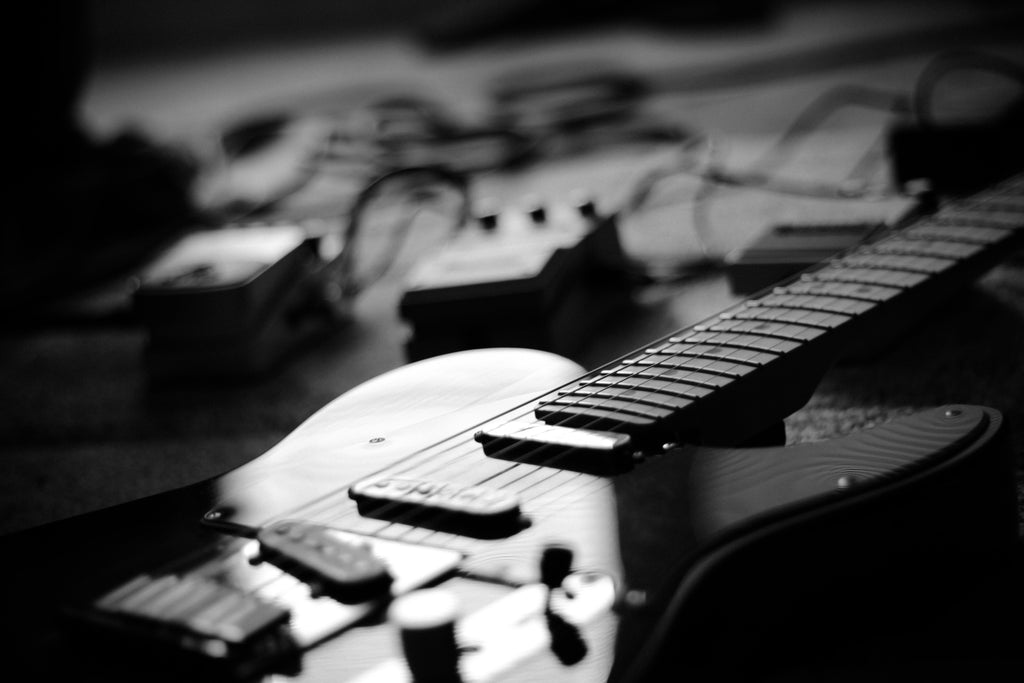
In addition, you can store your old guitar picks in a box. I wish I still had my first guitar pick, that I used, when I was learned to play guitar as a child. A guitar pick can be a beautiful piece of your past.
Check Your Pick Condition Regularly
A tip from my side, is to double check every guitar pick before going out on stage, or studio. A visual inspection is fine.
Always keep some unused plectrums aside. Considering plectrums are probably the least expensive gear of your complete guitar rig, constant wear and tear issues is not a thing you should worry about.

Choose your ideal Plectrum
Are you using the right pick? This is a question you should ask yourself every time you play a song.
Some players have their 5-favourites, depending on the style and type of guitar they want to play.
The most important factors when choosing the right plectrum for you hinges on….
- Material
- Shape
- Thickness
- Size
- Playing style
- Your personal preference
We created a guide that will help you find the right plectrum for you.
You can find it HERE.
Thank you!
The support we are getting from the guitar community makes us very happy!
We, (Carlos and Judith), are really doing our best to create the best guitar picks for you.
If you consider supporting a small family start-up, you can share this article and directly have an influence on our online visibility.
These small actions have helped us since January 2019, and we count on your support! :)

Thanks!

Guitar Pick Grip: Why Textures On Guitar Pick Surfaces Can Help Improve Your Playing Experience
The surface of a guitar pick is in direct contact with your fingers. You feel it when you hold your pick, and your guitar strings will touch the surfaces every time you play a chord or a guitar solo.
Textures on guitar picks define not only important things like grip, control, and friction between the strings and guitar pick, but also equally important details like comfort, pick noise, and design.

Why Should The Different Areas Of The Guitar Pick Have Different Texture Types?
The guitar pick consists of two areas: The hold area (body), and the attack area (tip).
Both areas have different requirements. Generally speaking, when combining the proper textures of these two areas, a guitar pick should offer:
- a comfortable surface to hold the pick securely
- a well-designed tip to promote precision

With this simple fact in mind, it seems logical to differentiate these two areas when it comes to choosing the texture of the guitar pick.
Guitar Pick Hold Area:
The body of the guitar pick is the part of the plectrum, which you use to hold it.The textures on the body will directly affect:
- the control of the guitar pick
- the grip of the guitar pick
- the comfort of the guitar pick
These three features are strictly connected and every guitar player will have a very subjective opinion of them.
Guitar Picks With Grippy Surface:
These are specifically designed guitar picks. These guitar picks won’t slip so easily and the texture on the hold area will provide the guitar player with enough grip.
Advantages Of Guitar Picks With Grippy Surfaces:
-
Control the position of the pick between your fingers: avoid rotation and pick slippage.
-
Hold the pick with less tension, which results in a better playing experience and less hand fatigue.
Common Types Of Grippy Guitar Picks:

-
Sandpaper grip: Maximum grip, very aggressive texture (uncomfortable for long playing sessions)
-
Raised geometries or logos: High grip, aggressive texture (can feel uncomfortable for long playing sessions).
-
Micro-nodules texture: Medium/High grip, comfortable texture (the micro-nodules fit between the grooves of your skin). Read more here.
-
Grip Holes: Medium Grip
-
Homemade guitar pick grip: Some players use tape or make scratches on the pick to create a custom experience.
It is up to you to find a balance between comfort and grip. Some players prefer non-sticky guitar picks, some others need the maximum grip available.
The best thing you can do is try all different textures and decide yourself, considering the playing style you have.
For guitar sessions for over 1 hour, I prefer comfort over the grip. Once you get used to the guitar pick and how it reacts after every impact, you appreciate the comfort more and the playing experience texture and design can give you.
Guitar Pick Attack Area:
The texture on the tip of the plectrum will have a direct influence on:- Durability
- Pick Noise
The texture on this guitar pick area is one of the most undiscovered features in the guitar pick world. Read more here.
How can a polished guitar pick improve durability and reduce noise?
Actually, it is very simple: A mirror polished guitar pick will reduce friction between guitar pick and strings. With every impact, the guitar pick will suffer less friction and therefore wear down slower.
With less friction, the pick will cause less pick noise. From my own experience, guitar picks with this attribute make me want to play forever.
In addition, the pick will glide better and provide a better playing experience. However, this is a very subjective point since other types of guitar picks with coarse textures on the tip are very popular amongst some guitarists. Pick noise is sometimes wanted when strumming chords.
Bonus Feature: Unique Designs:
This is a bonus argument I always use: Combining different textures in one pick can be very useful for creating unique designs.Guitar pick surfaces not only affect the function, but also the aesthetics.
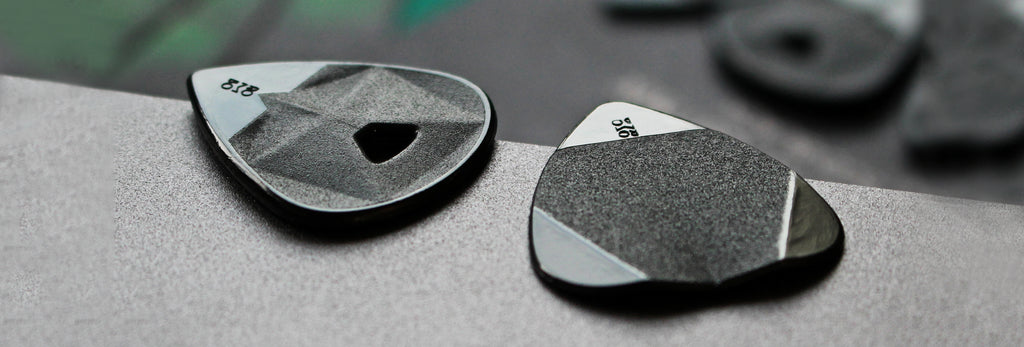
In order to build your own image, you need gear that fits in it. Design is as important as the other aspects when it comes to music gear.
Fortunately, we live in an era where many brands are creating very original designs with the best functionality.
Guitar Pick Grip: What Textures Are We Using At Rombo?
We believe textures on guitar picks are essential for a tool that was designed to be held between your fingers
The combination of two different surface finishes in the guitar picks have convinced us and our testers of the potential gains a player can achieve:
- A polished tip for clarity, durability and control
- A micro-nodules texture in the centre of the guitar pick for the most comfortable holding without compromising grip
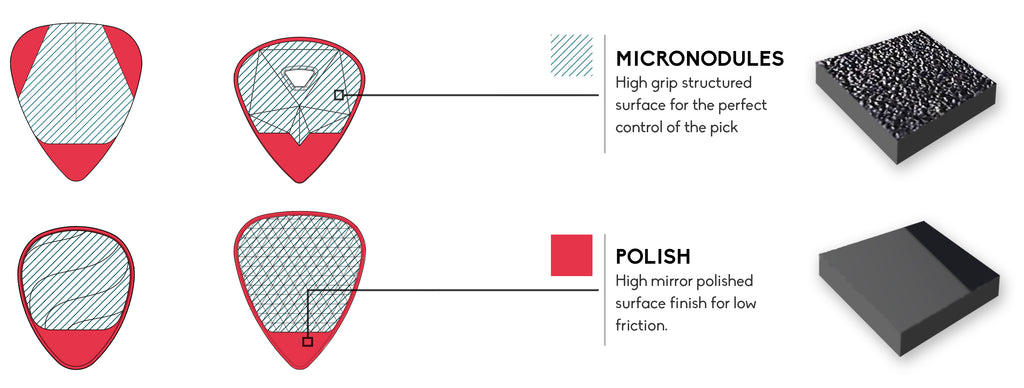
Conclusion:
Grippy textures can help you hold the guitar pick more firmly without effort.
Looking for a texture you feel comfortable with is essential to find the balance between grip and comfort.
However, what about thickness, shape, size, and material? Have you thought about these attributes?
Learn more in our article "How to choose the right guitar pick".
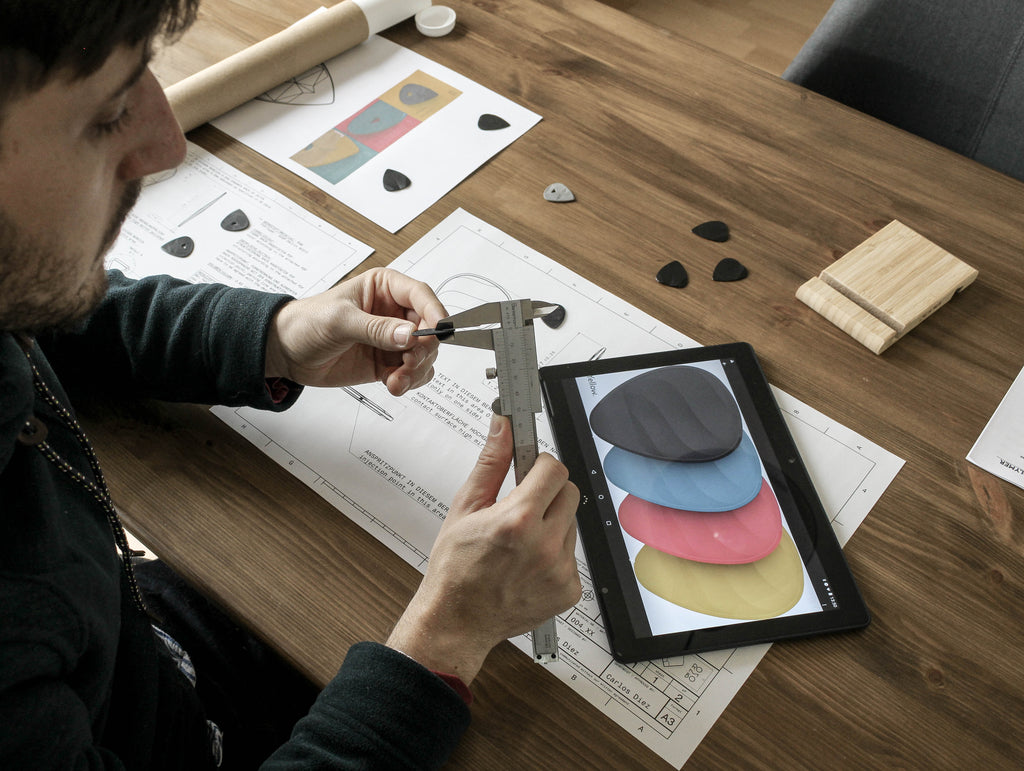
Folge uns
Judith Heindorf & Carlos Diez Macia GbR
Auf der Steige 29
71686 Remseck am Neckar
DEUTSCHLAND
- Shop
- Händler
- Impressum
- AGB
- Widerrufsrecht
- Versandbedingungen
- Datenschutzerklärung
- Kontakt
- Presse
- Fragen & Antworten
Melde dich zu unserem Newsletter an und erhalte alle Neuigkeiten zu Sales, Neuerscheinungen und vielem mehr…
Mit der Anmeldung stimmst du unseren Datenschutzbedingungen zu.
© 2024 ROMBO.
ist eine registrierte EU-Marke.
Wir nutzen Shopify.


